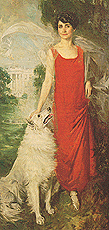

Biography: For her "fine personal influence exerted as First Lady of the Land," Grace Coolidge received a gold medal from the National Institute of Social Sciences. In 1931 she was voted one of America's twelve greatest living women.
She had grown up in the Green Mountain city of Burlington, Vermont, only child of Andrew and Lemira B. Goodhue, born in 1879. While still a girl she heard of a school for deaf children in Northampton, Massachusetts, and eventually decided to share its challenging work. She graduated from the University of Vermont in 1902 and went to teach at the Clarke School for the Deaf that autumn.
In Northampton she met Calvin Coolidge; they belonged to the same boating, picnicking, whist-club set, composed largely of members of the local Congregational Church. In October 1905 they were married at her parents' home. They lived modestly; they moved into half of a duplex two weeks before their first son was born, and she budgeted expenses well within the income of a struggling small-town lawyer.
To Grace Coolidge may be credited a full share in her husband's rise in politics. She worked hard, kept up appearances, took her part in town activities, attended her church, and offset his shyness with a gay friendliness. She bore a second son in 1908, and it was she who played backyard baseball with the boys. As Coolidge was rising to the rank of governor, the family kept the duplex; he rented a dollar-and-a-half room in Boston and came home on weekends.
In 1921, as wife of the Vice President, Grace Coolidge went from her housewife's routine into Washington society and quickly became the most popular woman in the capital. Her zest for life and her innate simplicity charmed even the most critical. Stylish clothes--a frugal husband's one indulgence--set off her good looks.
After Harding's death, she planned the new administration's social life as her husband wanted it: unpretentious but dignified. Her time and her friendliness now belonged to the nation, and she was generous with both. As she wrote later, she was "I, and yet, not I--this was the wife of the President of the United States and she took precedence over me...." Under the sorrow of her younger son's sudden death at 16, she never let grief interfere with her duties as First Lady. Tact and gaiety made her one of the most popular hostesses of the White House, and she left Washington in 1929 with the country's respect and love.
For greater privacy in Northampton, the Coolidges bought "The Beeches," a large house with spacious grounds. Calvin Coolidge died there in 1933. He had summed up their marriage in his Autobiography: "For almost a quarter of a century she was borne with my infirmities, and I have rejoiced in her graces." After his death she sold The Beeches, bought a smaller house, and in time undertook new ventures she had longed to try: her first airplane ride, her first trip to Europe. She kept her aversion to publicity and her sense of fun until her death in 1957. Her chief activity as she grew older was serving as a trustee of the Clarke School; her great pleasure was the family of her surviving son, John.



1901 - 1953
Mrs. Theodore Roosevelt - Mrs. Truman
Grace Anna Goodhue Coolidge
Elizabeth Virginia Wallace Truman
President and First Lady | Vice President and Mrs. Gore
Record of Progress | The Briefing Room
Gateway to Government | Contacting the White House | White House for Kids
White House History | White House Tours | Help
Privacy Statement